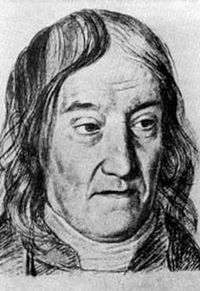Farkas Bolyai
| Farkas Bolyai | |
|---|---|
|
Farkas Bolyai | |
| Born |
9 February 1775 Bólya near Hermannstadt/Hermannstadt, Grand Principality of Transylvania, Habsburg Empire (now Buia, Sibiu County, Romania) |
| Died |
20 November 1856 (aged 81) Marosvásárhely, Transylvania, Austrian Empire (now Târgu Mureş, Romania) |
| Residence | Habsburg Empire, Austrian Empire |
| Nationality | Hungarian |
| Fields | Mathematics |
| Alma mater |
University of Jena University of Göttingen |
| Academic advisors | Abraham Gotthelf Kästner[1] |
| Notable students | János Bolyai |
| Known for |
Contributions to the foundations of geometry Wallace–Bolyai–Gerwien theorem |
Farkas Bolyai (Hungarian: [ˈfɒrkɒʃ ˈboːjɒi]; 9 February 1775 – 20 November 1856; also known as Wolfgang Bolyai in Germany) was a Hungarian mathematician, mainly known for his work in geometry.
Biography
Bolyai was born in Bólya, a village near Hermannstadt, Grand Principality of Transylvania, Habsburg Empire (now Buia, Sibiu County, Romania). His father was Gáspár Bolyai and his mother Krisztina Vajna. Farkas was taught at home by his father until the age of six when he was sent to the Calvinist school in Nagyszeben. His teachers recognized his talents in arithmetics and in learning languages. He learned Latin, Greek, Romanian, Hebrew and later also French, Italian and English. At the age of 12 he left school and was appointed as a tutor to the eight-year-old son of the count Kemény. This meant that Bolyai was now treated as a member of one of the leading families in the country, and he became not only a tutor but a real friend to the count's son. In 1790 Bolyai and his pupil both entered the Calvinist College in Kolozsvár (today Cluj-Napoca) where they spent five years.
The professor of philosophy at the College in Kolozsvár tried to turn Bolyai against mathematics and towards religious philosophy. Bolyai, however, decided to go abroad with Simon Kemény on an educational trip in 1796 and began to study mathematics systematically at German universities first at Jena and then at Göttingen. In these times Bolyai became a close friend of Carl Friedrich Gauss.
He returned home to Kolozsvár in 1799. It was there he met and married Zsuzsanna Benkő and where their son János Bolyai – later an even more famous mathematician than his father – was born in 1802. Soon thereafter he accepted a teaching position for mathematics and sciences at the Calvinist College in Marosvásárhely (today Târgu-Mureş), where he spent the rest of his life.
Mathematical work
Bolyai's main interests were the foundations of geometry and the parallel axiom.
His main work, the Tentamen (Tentamen iuventutem studiosam in elementa matheosos introducendi), was an attempt at a rigorous and systematic foundation of geometry, arithmetic, algebra and analysis. In this work, he gave iterative procedures to solve equations which he then proved convergent by showing them to be monotonically increasing and bounded above. His study of the convergence of series includes a test equivalent to Raabe's test, which he discovered independently and at about the same time as Raabe. Other important ideas in the work include a general definition of a function and a definition of an equality between two plane figures if they can both be divided into a finite equal number of pairwise congruent pieces.
He first dissuaded his son from the study of non-Euclidean geometry, but by 1830 he became enthusiastic enough to persuade his son to publish his path-breaking thoughts.
Notes
References
- (Romanian) A. Todea, F. Maria, M. Avram, Oameni de știință mureșeni - Dicționar biobibliografic, CJ Mureș Biblioteca Județeană Mureș, tipografia Mediaprint SRL, 2004
External links
-
 Quotations related to Farkas Bolyai at Wikiquote
Quotations related to Farkas Bolyai at Wikiquote - O'Connor, John J.; Robertson, Edmund F., "Farkas Bolyai", MacTutor History of Mathematics archive, University of St Andrews.
- Further references on Farkas Bolyai
- Farkas Bolyai at the Mathematics Genealogy Project
- The Bolyai Memorial Museum
